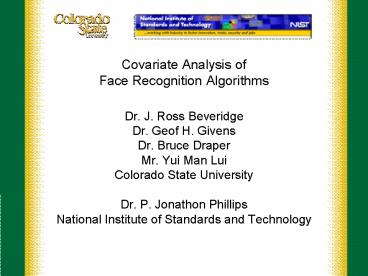Covariate Analysis of Face Recognition Algorithms - PowerPoint PPT Presentation
1 / 22
Title:
Covariate Analysis of Face Recognition Algorithms
Description:
Uncontrolled Lighting/Setting. 10/1/09. 6. CSU Symposiuum on ... Mugshot lighting, indoor uncontrolled, outdoor. Attributes of People. Gender, Race, Age. ... – PowerPoint PPT presentation
Number of Views:77
Avg rating:3.0/5.0
Title: Covariate Analysis of Face Recognition Algorithms
1
Covariate Analysis of Face Recognition Algorithms
- Dr. J. Ross Beveridge
- Dr. Geof H. Givens
- Dr. Bruce Draper
- Mr. Yui Man Lui
- Colorado State University
- Dr. P. Jonathon Phillips
- National Institute of Standards and Technology
2
But Wait - Someone Said LIDAR
Work on LADAR (LIDAR) Recognition - 1997
3
Back to Faces - FRVT 2006
- NIST Sponsored Evaluations date back to the mid
1990s - Recent - FRVT 2006
4
Face Recognition Progress
Fig. 1 from FRVT 2006 Summary
Caveat - this is for well controlled imagery!
2006 - Falsely turn away 1/100 people, when only
admitting 1/1000 imposters.
5
Uncontrolled Lighting/Setting
6
FRVT 2006 Uncontrolled
Fig. 7 from FRVT 2006 Summary
Turn Away 20/100
2006 - Falsely turn away 10/100 to 40/100
people, when only admitting 1/1000 impostors.
7
Scope of the Study
- Algorithm - score fusion of 3 top performers.
- Imagery - Uncontrolled match to Controlled.
- Subset of FRVT 2006 Experiment 4
- 345 subjects and 110,514 match scores.
8
Scope - Covariates
- Performance Variable
- Verification Outcome, Success of Failure.
- False Accept Rate - FAR
- Properties of Environment
- Mugshot lighting, indoor uncontrolled, outdoor.
- Attributes of People
- Gender, Race, Age.
- Measurable Properties of Imagery
- Distance between Eyes.
- Face Region In Focus Measure (FRIFM).
- An edge-density measure by Eric Krotkov
Active Computer Vision by Cooperative Focus
and Stereo by Eric Krotkov.
9
Generalized Linear Mixed Model
Analysis is Mixed Effects Logistic
Regression with Repeated Measures on People.
- Let A and B be 2 covariates that might influence
algorithm performance. For example, Agender
(categorical) and BQuery-Eye-Distance
(continuous). - Let a index levels of A.
- Let j index the FAR setting, ?j
- Ypabj is
- 1 if Person p is verified correctly, 0 otherwise.
- Ypabj depends on
- person p, covariates A and B, and
- false alarm rate ?j.
Geof Givens, Statistics
10
Finding 2 Gender
11
Finding 4 Glasses
12
Face Region In Focus Measure
- FRIFM Sum of Sobel edge magnitude inside an
ellipse bounding the face.
13
Face Region In Focus Measure
Low FRIFM examples
High FRIFM examples
14
Finding 5
Small
Medium
Large
15
Finding 5
Small
Medium
Large
Size of query image (distance between eyes)
16
Finding 5
Small
Medium
Large
Query environment
17
Finding 5
Small
Medium
Large
Boundary of observed data
18
Finding 5
Small
Medium
Large
Large PV range 0.90 ? 0.10
19
Finding 5
20
- Thank You
21
GLMM Model Continued
22
Subject Variation
The Mixed in Generalized Linear Mixed effect
Model.
This means
The outcomes, i. e. verification success/failure,
are uncorrelated when testing different people
but correlated when testing the same person under
different configurations.































